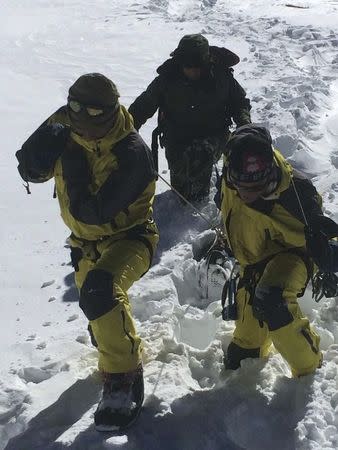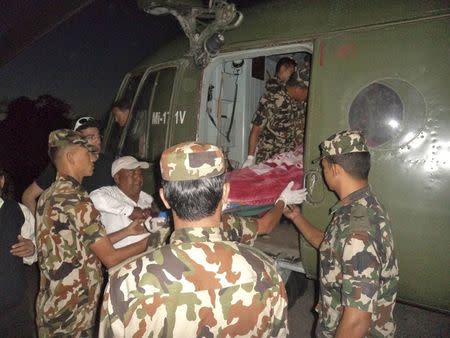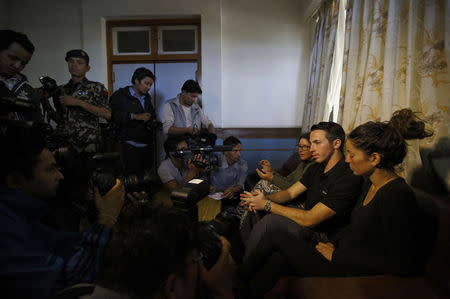Nepal blames poor forecasts, lax rules for trek disaster
By Rupam Jain Nair and Gopal Sharma KATHMANDU (Reuters) - Nepal's prime minister on Friday promised to set up an early weather warning system after at least 29 people were killed in a blizzard on a popular Himalayan trekking route, raising concerns that amateurs were ill prepared for such expeditions. Nepal's government blamed poor weather forecasts and lax regulation after the storm struck at high altitude on the edge of the Tibetan plateau, close to the world's 10th highest mountain, stranding scores of foreign tourists and Nepali guides in waist-high snow with little shelter. At least 150 people were injured. A lack of records makes it difficult to calculate the number of missing Nepalis. Nepal relies heavily on income from climbers and trekkers. The latest accident has renewed focus on the mountain sports industry after 16 Sherpas died in an avalanche on Mount Everest in April in the deadliest accident on the world’s highest peak. The government failed to issue any warnings about the risk of snow or avalanches as scores of tour groups set off towards the 5,416-metre-high (17,769 feet) Thorong La pass on Tuesday during the peak climbing season, favoured by tourists because the air is generally cool and clear. Prime Minister Sushil Koirala promised to set up early weather warning centres in mountain and river areas and called on the private sector to help the cash-strapped government. "It is a matter of great sadness that so many people lost their lives at a time when there are facilities to receive global weather information regularly. "This incident, which comes a few months after the one on Sagarmatha (Mount Everest), has underlined the need to consider the development of tourism in a new way," Koirala said. Nepal's chief secretary Lella Mani Paridyal told Reuters: "We are in a state of shock and this disaster is a wake-up call. The weather forecast was faulty, inaccurate, and this will not be tolerated any more." Nepal's weather forecasting system predicted rain but no snow brought by the tail-end of a cyclone that struck India last weekend, government officials said. Until now the government has set few limits on tour groups, partly because climbing and trekking are an $800-million-a-year business in a country that is one of the poorest in the world. Mountain rescue teams continued to search for survivors on Friday dropping from helicopters to rescue about 40 hikers trapped for three days on a Himalayan pass that had remained inaccessible since the blizzard struck. ADVENTURE TOURISM "We were not informed the weather would get so treacherous. My tour guide got us all the permits and told me his company had taken care of everything," said Eitan, an Israeli mountaineer. "I knew there was a cyclone hitting India but was not aware that it could impact Nepal. If the country believes it offers the best adventure tourism experience, then it should give the best protection to adventure tourists. No one will come to Nepal if they don't make immediate changes." The government said the time had come to curb the dangers to foreigners and local staff who earn their livelihoods accompanying them up the mountains."At present we are seeing that nobody is following the rules," said Yadav Koirala, Nepal's joint secretary of disaster management. "There is faulty mechanism at every level."Daily weather forecasts will be reviewed before a decision is made on whether to allow tourists on to the mountains, a government official said, adding the government would force all tourists and guides to purchase a tracking device to make it easier to locate people if there was a disaster. The ferocity of the storms took even experienced trekkers and locals by surprise. Survivors recounted tales of having to pass dying people as they tried to reach lower altitudes. Mountaineering professionals said they were sceptical that the government would be able to quickly impose order. "Thus far I have seen so little regulation from the Nepali government beyond what profits they can take from this trekking and climbing industry," said Adrian Ballinger, a Canadian mountain guide who organises treks in the Himalayas. "I see so many issues with Nepal instituting systems that are well intentioned that don't actually work." Inexperienced trekkers and tour agencies were equally to blame for many mountain accidents because they lacked the right equipment and did not employ experienced guides, Ballinger said. Every year, thousands of tourists traverse Thorong La, the highest point of a three-week loop around the Annapurna peak, where several people have been killed. It is a wide, barren cleft between some of the world's highest mountains and offers scant shelter.Authorities said they had little idea how many Nepalis were missing from remote villages near the Tibetan border. Unlike tourists, Nepalis do not need to register to enter the mountain areas."Nepalis do not need a permit and so we have no idea about how many Nepalis could be missing," said Koirala of the disaster management authority. He said about 150 Nepalis were on the mountain when the snowfall started. (Writing By Andrew MacAskill; Editing by Janet Lawrence)




